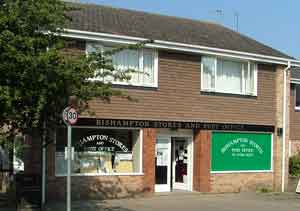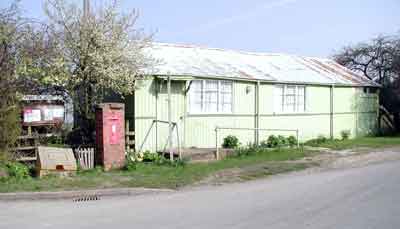
Photo 6: Bishampton Village Stores
In the ‘Hot Topics’ Questionnaire, the second largest group of comments was that concerning various aspects of ‘Village Life’.
The comments covered quite a broad range of issues:-
The Parish Plan survey aimed to probe the views of parishioners about these issues, and to measure their importance to respondents.

The pub, shop and hairdressers are all in Bishampton as is the Villages Hall, which has recently undergone major refurbishment. Whilst the Villages Hall serves Bishampton, Abberton and Throckmorton most Throckmorton respondents tend to view, the now dilapidated, Throckmorton Parish Room as their “village hall”.
Built around 1900 the Parish Room in Throckmorton was given by Throckmorton parish to the Scout Association in the 1970’s who used it until the 1980’s. Since then it has been rented from them by the Parish Council. The Throckmorton Charity has recently purchased the room from the Scout Association. Since the building is beyond economic repair, and in line with strong local feeling, the charity is hoping to demolish the building and replace it with a new parish room incorporating a small car park.

There is a play area in Throckmorton leased to the Parish Council by a local landowner for a peppercorn rent but it has no equipment. The play area in Bishampton, located at the Villages Hall, is equipped with basic swings and a slide for very young children.
Households were asked to indicate how often they used the facilities in the villages, choosing between ‘never’, ‘rarely,’ ‘sometimes’, frequently’ and ‘very frequently’.
The results perhaps reflect the difficulties facing many rural communities. While the majority of responding households reported rarely or never using one or two amenities, the survey clearly indicates that local people do use local services. Combining all frequencies of use (i.e. adding up 'very frequent', 'frequent', 'sometimes' and 'rarely' to give a measure of any use) over two thirds of households reported use of the shop, village hall, pub and church, and even the less used facilities were used by between a quarter and a half of households. Indeed, every household from Bishampton who replied reported using the shop.
Table 3 illustrates the percentage of households using village amenities with Bishampton and Throckmorton figures in the shaded columns. The left hand block indicates the percentage of households who made frequent use of the amenity. The second block records the percentage that made regular use of the amenity (derived by adding those who answered 'very frequently', 'frequently' or 'sometimes'). The final column is the overall percentage of households who made any use whatsoever of the amenity (i.e. any household which did not tick the never option)
Frequent Use |
Regular Use |
Any Use |
||||||||
(B) |
(T) |
(B) |
(T) |
(B) |
(T) |
|||||
Shop |
69 |
(82) |
(20) |
87 |
(96) |
(58) |
94 |
(100) |
(76) |
|
Hall |
29 |
(33) |
(15) |
66 |
(68) |
(56) |
87 |
(90) |
(72) |
|
Pub |
17 |
(20) |
(19) |
56 |
(62) |
(42) |
78 |
(85) |
(61) |
|
Church |
13 |
(12) |
(15) |
39 |
(38) |
(39) |
73 |
(73) |
(69) |
|
Play areas |
21 |
(24) |
(9) |
33 |
(37) |
(18) |
45 |
(51) |
(24) |
|
Hairdressers |
16 |
(16) |
(15) |
25 |
(25) |
(24) |
27 |
(34) |
(28) |
|
Classes |
3 |
(4) |
(2) |
14 |
(11) |
(7) |
29 |
(28) |
(19) |
|
Table
3: Percentage of households making use of village amenities |
||||||||||
The shop, village halls, and pub, are used regularly but, of course, viability does not just depend on the percentage of households using a service. In small rural communities such as Bishampton and Throckmorton, even two-thirds of household making frequent of a service may not ensure viability, much as it indicates how valued the service is.
The survey also asked people to indicate the order of importance they attached to the different amenities. The order of priority households gave corresponded to their actual use of services.
So while the survey confirms some fears about the viability of some local amenities, those that residents consider more important, and by inference more necessary to sustaining village life, do attract the greater use.
The survey also asked people to indicate the degree to which they felt satisfied with the provision and maintenance of the main services – water, electricity, telecommunications, sewerage and storm drains.
With the exception of storm drainage, the majority of households considered the services adequate or better.
Bishampton has had a recurring problem with flooding in Main Street and Broad Lane. Not surprisingly this was reflected in the majority of households considering that the storm drains were poor or worse. Throckmorton residents, whilst less complimentary than for the other services, on the whole considered the state of the storm drains adequate or better.
Overall, respondents were satisfied with the state of local public footpaths and bridleways. The majority of Bishampton residents considered signs, access and clearance of footpaths and bridleways as adequate or better. Throckmorton residents were less satisfied, though still, on balance, judging signage and access as adequate. However, almost half deemed the clearance of footpaths as poor or worse, reflecting the practice of some landowners who do not keep footpaths clear.
Around 70% of households reported feeling unsupported by the presence of police; 65% of Bishampton households reported some degree of concern about crime, whilst only 40% of Throckmorton households did.
The survey revealed the importance paid to local amenities and services as well as some of the problems or shortcomings experienced by residents.
The Parish Council supports a range of local groups with grants and other support. It will continue to do this.